Mgahinga Gorilla National Park is part of the wider Virunga conservation region that also includes the volcanoes national park in Rwanda and the Virunga National Park in the Democratic Republic of Congo. The park is located on the south-western corner of Uganda in the town of Kisoro. Mgahinga was upgraded from a game reserve into a full national park in 1991 mainly to protect the mountain gorillas that were in frequent conflicts with humans living within and outside the park.
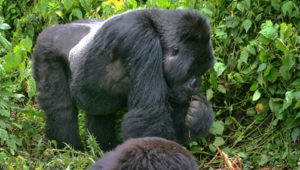 Mgahinga is the smallest national park in Uganda and covers an area of 34 square kilometers. The park gets its name from a Kinyarwanda word “Gahinga” referring to the small lava stones common in gardens at the foot of the mountain.
Mgahinga is the smallest national park in Uganda and covers an area of 34 square kilometers. The park gets its name from a Kinyarwanda word “Gahinga” referring to the small lava stones common in gardens at the foot of the mountain.
Though a small park, what really sets Mgahinga apart is the natural beauty. The park is characterized by Savannah grasslands, woodlands, tropical forests, montane forests, marshes/swamps, bamboo forests, Afro-montane forests, bogs and semi-alpine vegetation. The most prominent features in the park are the three inactive volcanoes – Mount Gahinga, Mount Sabyinyo and Mount Muhabura. These mountains form part of the great Viringa ranges of mountains that include Karisimbi, Bisoke, and Nyiragongo among others. Because of the three mountains much of the park lies on high altitude of between 2,000 to 4,000 metres.
The mountains along with thick forest cover influence climatic conditions in the park bringing frequent rains and a cool breeze. Mgahinga Gorilla National Park is a vital water catchment area. Several streams flow from Crater the Lakes and swamps on the mountain summit to the rivers and lakes on the floor. On the slopes of the mountains, there are rivers like Ntebeko, Nyabirerema and Kabiranyuma which supply water to the indigenous tribes living next to the park.
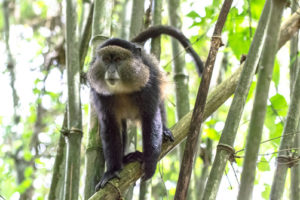 The main attractions in the park are the mountain gorillas but Mgahinga National Park is also home to the endangered golden monkeys, Vervet monkeys, Spotted hyenas, Serval cats, Red tailed monkeys, Patas monkeys, Mangabeys, Leopards, Golden cats, Forest hogs, Elephants, Bushbucks, Bushbabies, Buffaloes, Blue monkeys,, Baboons, African porcupines, Black and white Colobus monkeys. The reptiles in the park include snakes, geckos and chameleons to mention but a few. We will discuss more about the birds shortly.
The main attractions in the park are the mountain gorillas but Mgahinga National Park is also home to the endangered golden monkeys, Vervet monkeys, Spotted hyenas, Serval cats, Red tailed monkeys, Patas monkeys, Mangabeys, Leopards, Golden cats, Forest hogs, Elephants, Bushbucks, Bushbabies, Buffaloes, Blue monkeys,, Baboons, African porcupines, Black and white Colobus monkeys. The reptiles in the park include snakes, geckos and chameleons to mention but a few. We will discuss more about the birds shortly.
The Bafumbira, Batwa and Bakiga are the main indigenous tribes living on the edges of the forest. They rely mainly on subsistence farming on the slopes of the mountains using terracing. Population pressure and resulting lack of 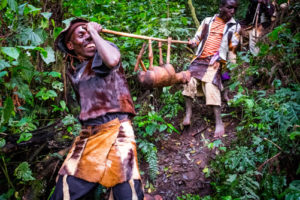 alternative ways of earning income has over the years resulted in human encroachment and pressure on the park land and forest leading to deforestation in areas close to human settlements. The bamboo and sub-alpine vegetation on the foot and higher up the mountains remain relatively intact. Although the Uganda Wildlife Authority (UWA) has contained poaching, continued population group among communities living outside the park remains a threat. UWA has come up with community tourism programmes that have created a harmonious relationship between the local tribes, park authorities and creatures therein.
alternative ways of earning income has over the years resulted in human encroachment and pressure on the park land and forest leading to deforestation in areas close to human settlements. The bamboo and sub-alpine vegetation on the foot and higher up the mountains remain relatively intact. Although the Uganda Wildlife Authority (UWA) has contained poaching, continued population group among communities living outside the park remains a threat. UWA has come up with community tourism programmes that have created a harmonious relationship between the local tribes, park authorities and creatures therein.
How to get to Mgahinga Gorilla National Park
Mgahinga National Park can be reached by road or air from Kampala or Entebbe. The distance from Kampala is about 509 kilometers through well paved tarmac roads. Driving to the park from Kampala through the Mbarara-Masaka-Kampala highway takes about 9 hours. Lone travelers can hire the daily buses from Kampala to Kisoro town. 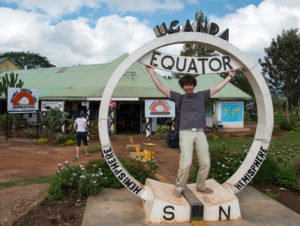 From Kisoro town, there are special hires and even motorcycles taking passengers up to the park gate. The road from Kibale town to Mgahinga National Park is made of Murram hence dusty, and bumpy. One needs a good 4X4 car to comfortably navigate through this stretch of road. Whereas the distance by road from Kampala seems long, the journey is worth it because of the beautiful scenery and opportunities to make short stops to check out hidden spots and even the equator crossing. One can also access Mgahinga National Park by using the shorter road from Kigali international airport through either the Katuna or Cyanika border with Uganda. This route takes less than 4 hours and is highly recommended.
From Kisoro town, there are special hires and even motorcycles taking passengers up to the park gate. The road from Kibale town to Mgahinga National Park is made of Murram hence dusty, and bumpy. One needs a good 4X4 car to comfortably navigate through this stretch of road. Whereas the distance by road from Kampala seems long, the journey is worth it because of the beautiful scenery and opportunities to make short stops to check out hidden spots and even the equator crossing. One can also access Mgahinga National Park by using the shorter road from Kigali international airport through either the Katuna or Cyanika border with Uganda. This route takes less than 4 hours and is highly recommended. 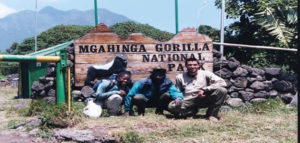 Ever since the government of Rwanda increased the price of gorilla permits to $1500, Mgahinga receives more tourists from the Rwanda side who are more comfortable with the $600 charged in Uganda.
Ever since the government of Rwanda increased the price of gorilla permits to $1500, Mgahinga receives more tourists from the Rwanda side who are more comfortable with the $600 charged in Uganda.
Those on a tight schedule can choose to take a chartered flight from Entebbe international airport or Kajjansi airstrip (in Kampala) to Kisoro airstrip near the park. Flights from Eagle Air between Entebbe and Kisoro are arranged every Monday and Friday of the week. Tickets for the local flight need to be booked in advance. Tour companies can help you book the local flight and arrange ground transportation from the Kisoro airstrip to the park.
Things to do in Mgahinga Gorilla National Park
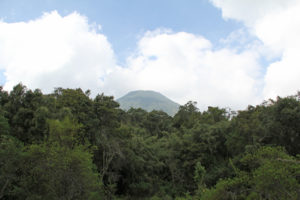 One of the advantages of visiting Mgahinga national park is that there are fewer crowds. The whole park can be discovered in peace and quiet. Some of the activities don’t need to be booked in advance. Many of the activities don’t need to be booked in advance.
One of the advantages of visiting Mgahinga national park is that there are fewer crowds. The whole park can be discovered in peace and quiet. Some of the activities don’t need to be booked in advance. Many of the activities don’t need to be booked in advance.
There are several activities that travelers can engage in while at Mgahinga Gorilla National Park including gorilla trekking, golden monkey tracking, mountain climbing, nature walks, cultural visits and bird watching among others. The best way to start is by looking at our 3 Days gorilla tour in Mgahinga package. Most of these activities start from the visitor center in Ntebeko. The activities are:-
Gorilla tracking: In Bwindi and Mgahinga, Uganda is lucky to have two national parks where mountain gorilla trekking can be done. About 80 mountain gorillas are found in Mgahinga National Park. 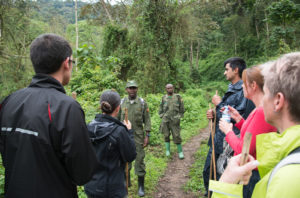 Because they stay in high altitudes, the gorillas in Mgahinga have developed more fuzzy coats than those in Bwindi Impenetrable Forest. Only the Nyakagyezi gorilla group is open to tourism in Mgahinga. The Nyakagezi group is one of the two largest habituated mountain gorilla groups in Uganda, Congo and Rwanda. The group used to be very mobile with a tendency to cross to Rwanda and even Congo but have for the past five years settled in Uganda. It takes a shorter time locating the Nyakagyezi group than some families in Bwindi.
Because they stay in high altitudes, the gorillas in Mgahinga have developed more fuzzy coats than those in Bwindi Impenetrable Forest. Only the Nyakagyezi gorilla group is open to tourism in Mgahinga. The Nyakagezi group is one of the two largest habituated mountain gorilla groups in Uganda, Congo and Rwanda. The group used to be very mobile with a tendency to cross to Rwanda and even Congo but have for the past five years settled in Uganda. It takes a shorter time locating the Nyakagyezi group than some families in Bwindi.
Gorilla trekking in Mgahinga starts at 8 am with briefing. After the briefing, visitors are led by the park rangers to find the group. 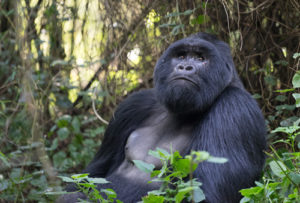 While tracking the gorillas expect to encounter pristine forest, primates, birds and other forest creatures. The time taken tracking the gorillas will depend on the location of the group that day and can take anywhere between 2 to 3 hours. Go prepared with a good camera to capture one of the most amazing wildlife experiences. Will you see the primates? Well, the chances of seeing mountain gorillas is pretty high. There is a packing list for gorilla trekking and rules for gorilla tracking that every tracker needs to be conversant with. The cost of a gorilla permits in $600 and can be acquired from the Uganda Wildlife Authority offices in Kisoro or through a tour operator. The best time of the year for gorilla trekking is between June and August.
While tracking the gorillas expect to encounter pristine forest, primates, birds and other forest creatures. The time taken tracking the gorillas will depend on the location of the group that day and can take anywhere between 2 to 3 hours. Go prepared with a good camera to capture one of the most amazing wildlife experiences. Will you see the primates? Well, the chances of seeing mountain gorillas is pretty high. There is a packing list for gorilla trekking and rules for gorilla tracking that every tracker needs to be conversant with. The cost of a gorilla permits in $600 and can be acquired from the Uganda Wildlife Authority offices in Kisoro or through a tour operator. The best time of the year for gorilla trekking is between June and August.
Golden Monkey Tracking: Golden monkeys are subspecies of blue Monkeys. The primates are endemic to the Albertine Rift and Virunga ranges in Uganda, Rwanda and The Democratic Republic of Congo. They look cute with beautiful golden coats. Golden monkeys are rather small monkeys with an adult weighing about twenty pounds. They are very playful and active primates living in large groups that can contain 80 individuals. They spend most of their time on top of trees feeding off bamboo shoots or insects on the slopes of the volcanoes. Their chief predator is the African Eagle.
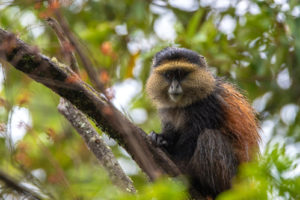 Golden monkeys are one of the most sought out primates by tourists in Africa. It is only Rwanda (Volcanoes National Park) and Uganda (Mgahinga National Park) that have habituated groups open to tourists. Golden monkey tracking takes between thirty minutes to three hours. The activity starts at 8am with briefing. Because they can’t hear eagles coming when it’s raining, the monkeys tend to hide away during downpour making the chances of finding them 85%. After finding the monkeys, visitors are only allowed 1 hour to observe the behavior of the group while also taking photos. There is a possibility of going for the longer golden monkey habituation experience with researchers but at an extra cost. Golden Monkey Permits cost $100. You can find out more information about the 2 days golden monkey trekking in the Volcanoes National Park.
Golden monkeys are one of the most sought out primates by tourists in Africa. It is only Rwanda (Volcanoes National Park) and Uganda (Mgahinga National Park) that have habituated groups open to tourists. Golden monkey tracking takes between thirty minutes to three hours. The activity starts at 8am with briefing. Because they can’t hear eagles coming when it’s raining, the monkeys tend to hide away during downpour making the chances of finding them 85%. After finding the monkeys, visitors are only allowed 1 hour to observe the behavior of the group while also taking photos. There is a possibility of going for the longer golden monkey habituation experience with researchers but at an extra cost. Golden Monkey Permits cost $100. You can find out more information about the 2 days golden monkey trekking in the Volcanoes National Park.
Mountain climbing: One of the attractive activities in Mgahinga is climbing one of the three volcanoes found in the park – Sabyinyo, Gahinga (3474) and Muhavura (4127m). Sabinyo is thought to be the oldest and Muhavura the youngest. These three volcanoes sit at the borders of Uganda, the Democratic Republic of Congo and Rwanda. At 3669 meters high, Mount Sabyinyo is the most popular volcano among hikers. Reaching the summit of Mount Sabyinyo provides a unique opportunity of standing in Uganda, Congo and Rwanda at the same time. The easiest climb is Mount Gahinga taking about six hours.
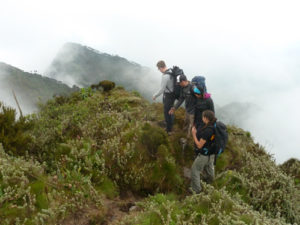 It is possible to hike to the top of all the three volcanoes in a period of three days. Climbing to the top of the three volcanoes will reward hikers with amazing views of all the three countries, the Virunga ranges of mountains, crater lakes, swamps, rare alpine vegetation, the Rwenzori Mountains, Bwindi impenetrable forest and Lake Edward. One needs to be mentally prepared and in good shape to complete hiking any or all of the volcanoes. Seasoned hikers may find hiking to the summit of these mountains easy but inexperienced hikers need to be well prepared. It is important to travel with packed food, water, a sleeping bag and a tent in case you end up spending a night at the top. The cost of climbing each of the volcanoes is $80.
It is possible to hike to the top of all the three volcanoes in a period of three days. Climbing to the top of the three volcanoes will reward hikers with amazing views of all the three countries, the Virunga ranges of mountains, crater lakes, swamps, rare alpine vegetation, the Rwenzori Mountains, Bwindi impenetrable forest and Lake Edward. One needs to be mentally prepared and in good shape to complete hiking any or all of the volcanoes. Seasoned hikers may find hiking to the summit of these mountains easy but inexperienced hikers need to be well prepared. It is important to travel with packed food, water, a sleeping bag and a tent in case you end up spending a night at the top. The cost of climbing each of the volcanoes is $80.
Bird Watching: Mgahinga National Park is one of Uganda’s best birding spots. Over 110 species of birds can be found in the caves, forests, lakes and mountains of Mgahinga National Park. The best time for birding in Mgahinga Gorilla National Park is during the months between April and May and October to November. 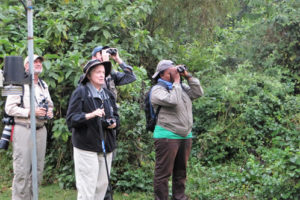 Most of the birds nest from November to April while the migrants from Europe come around November to April. Among the species to look out for are the Yellow-Vented Bulbul, yellow-throated long claw, White-starred Robin, White-necked raven, White-naped Raven, White-naped Raven, White Starred Robin, Western Green Tinker bird, Wax Bills, Thrush and Cinnamon Bracken Warbler, Striped breasted Tit, Streaky Seedeater, Stray seedeater, Stone Chat, Speckled Mousebird, Southern Red Bishop, Shelly’s Dusky Crimsonwing, Rwenzori Turaco, Rwenzori Nightjar, Rwenzori double-collared sunbird, Rwenzori Batis, Rufous chested swallow, Regal Sunbird, red-throated alethe, Red-faced Woodland Warbler, Red necked spur fowl, Pin-tailed whydah, Paradise Fly-catcher, Olive woodpecker, Olive Thrush, Olive Pigeon, Mountain
Most of the birds nest from November to April while the migrants from Europe come around November to April. Among the species to look out for are the Yellow-Vented Bulbul, yellow-throated long claw, White-starred Robin, White-necked raven, White-naped Raven, White-naped Raven, White Starred Robin, Western Green Tinker bird, Wax Bills, Thrush and Cinnamon Bracken Warbler, Striped breasted Tit, Streaky Seedeater, Stray seedeater, Stone Chat, Speckled Mousebird, Southern Red Bishop, Shelly’s Dusky Crimsonwing, Rwenzori Turaco, Rwenzori Nightjar, Rwenzori double-collared sunbird, Rwenzori Batis, Rufous chested swallow, Regal Sunbird, red-throated alethe, Red-faced Woodland Warbler, Red necked spur fowl, Pin-tailed whydah, Paradise Fly-catcher, Olive woodpecker, Olive Thrush, Olive Pigeon, Mountain 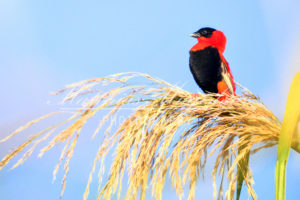 masked apalis, Montane nightjar, Malachite Sunbird, Scarlet-tufted Sunbirds, Kivu-ground Thrush, Ibis, Handsome Francolin, Grey Capped Warbler, Greater Double collard Sunbird, Grauer’s swamp warbler, Fly eagle, Firefinch, Fire Finch Stonechat, Dusky Turtle Dove, Dusky crimson wing, Double-collared sunbird, Doherty’s Bush-shrike, Crowned Hornbill, Crowned Crane, Collared apalis, Chubb’s Cisticola, Cape Robin-chat, Brown-crowned Tchagra, Brown Woodland Warbler, Bronze Sunbird, Blue-headed Sunbird, Blue-headed Coucal, Black-headed Waxbill, Black Kite, Banded Prinia, Archer’s ground robin, Archer’s Robin Chat and Alpine chat.
masked apalis, Montane nightjar, Malachite Sunbird, Scarlet-tufted Sunbirds, Kivu-ground Thrush, Ibis, Handsome Francolin, Grey Capped Warbler, Greater Double collard Sunbird, Grauer’s swamp warbler, Fly eagle, Firefinch, Fire Finch Stonechat, Dusky Turtle Dove, Dusky crimson wing, Double-collared sunbird, Doherty’s Bush-shrike, Crowned Hornbill, Crowned Crane, Collared apalis, Chubb’s Cisticola, Cape Robin-chat, Brown-crowned Tchagra, Brown Woodland Warbler, Bronze Sunbird, Blue-headed Sunbird, Blue-headed Coucal, Black-headed Waxbill, Black Kite, Banded Prinia, Archer’s ground robin, Archer’s Robin Chat and Alpine chat.
Nature walks: The pristine forests, lakes, rivers, swamps and mountain slopes of Mgahinga National Park offer perfect spots for nature walks. One of the walking trails lead up to the beautiful village plantations for a close encounter with some of the local folks like the Batwa.
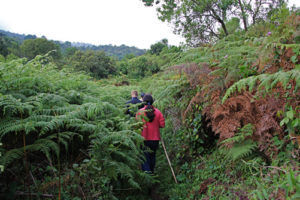 The border trail on the slopes of Mt. Sabyinyo leads to a point where the borders of Uganda, Rwanda and DR Congo meet. The trail takes about five hours to complete going through different vegetation types providing opportunities to see primates like the golden monkeys and the caldera on the Gisozi hill. The top of Gisozi hill also offers great views of the park, Bwindi impenetrable forest and the greater Virunga ranges of mountains. Some of the trails like the 5 hour Sabyinyo gorge walk are strenuous. This trail leads to steep areas of the park and will require good fitness levels to complete. The Sabinyo gorge involves completing a meandering walk on the slopes of Mount Sabyinyo to marvel at the different vegetation zones, birds and the volcanoes. While going for nature walks or using any of the trails, always be alert and listen to the sweet melodies coming from the resident birds and loud calls of monkeys as they jump from tree to tree. You might even encounter one of elusive large mammals like antelope and elephants.
The border trail on the slopes of Mt. Sabyinyo leads to a point where the borders of Uganda, Rwanda and DR Congo meet. The trail takes about five hours to complete going through different vegetation types providing opportunities to see primates like the golden monkeys and the caldera on the Gisozi hill. The top of Gisozi hill also offers great views of the park, Bwindi impenetrable forest and the greater Virunga ranges of mountains. Some of the trails like the 5 hour Sabyinyo gorge walk are strenuous. This trail leads to steep areas of the park and will require good fitness levels to complete. The Sabinyo gorge involves completing a meandering walk on the slopes of Mount Sabyinyo to marvel at the different vegetation zones, birds and the volcanoes. While going for nature walks or using any of the trails, always be alert and listen to the sweet melodies coming from the resident birds and loud calls of monkeys as they jump from tree to tree. You might even encounter one of elusive large mammals like antelope and elephants.
The Batwa Trail and Cultural Visit: There are a number of tribes living in the areas surrounding Mgahinga gorilla national park but the most interesting are the Batwa people. Why? Because their history is closely linked to the park. The Batwa lived in Mghinga forest for thousands of years as hunters and gathers before their eviction in 1991 and resettlement on the outskirts of the forest. While still in the forest, everything was easy and in plenty. All they needed to do each morning was wake up and go harvest honey, pick fruits, hunt animals or pick forests leaves for medicine. They could move about freely in the large forest without any restrictions. The Batwa rarely had conflicts with other tribes because few of them would dare invade them the forest.
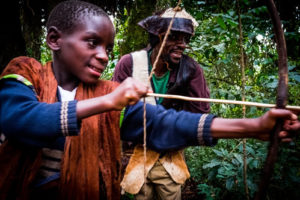 This life of plenty abruptly came to an end when the forest was turned into national park. The government concluded that their continued presence in the forest was hindering conservation activities and a threat to the mountain gorillas. Hunting was now considered poaching by the government. The government evicted them out of the forest and resettled them in areas around and beyond the park. Unfortunately their resettlement was not entirely successful because the Batwa have struggled to adapt to life outside the forest. Suddenly they had to deal with tribes they had avoided for thousands of years. They had to learn new ways of survival like agriculture and trade. The Batwa are marginalized by other tribes and seen as encroaching on their land. All these challenges have worsened the situation of the Batwa leaving them very poor in comparison to other tribes. Several local and international organizations have responded to the plight of the Batwa and initiated several livelihood projects and programmes. These projects help them identify new ways of generating income like rearing goats, chicken and bee keeping. Some of the organizations have even gone ahead to acquire land (with tittles) for the landless Batwa.
This life of plenty abruptly came to an end when the forest was turned into national park. The government concluded that their continued presence in the forest was hindering conservation activities and a threat to the mountain gorillas. Hunting was now considered poaching by the government. The government evicted them out of the forest and resettled them in areas around and beyond the park. Unfortunately their resettlement was not entirely successful because the Batwa have struggled to adapt to life outside the forest. Suddenly they had to deal with tribes they had avoided for thousands of years. They had to learn new ways of survival like agriculture and trade. The Batwa are marginalized by other tribes and seen as encroaching on their land. All these challenges have worsened the situation of the Batwa leaving them very poor in comparison to other tribes. Several local and international organizations have responded to the plight of the Batwa and initiated several livelihood projects and programmes. These projects help them identify new ways of generating income like rearing goats, chicken and bee keeping. Some of the organizations have even gone ahead to acquire land (with tittles) for the landless Batwa.
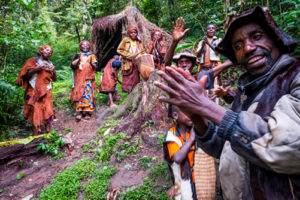 The Batwa Cultural trail is an immensely enriching experience and a chance to encounter a true indigenous African tribe. It is supported and encouraged by organizations like USAID. During this cultural experience, visitors get to learn about their past way of life and current challenge of dealing with a new life outside the safety of the forest. The Batwa Trail in Mgahinga is more comprehensive than the visit in Bwindi. It is led by the Batwa themselves and within the forest. These Batwa guides will endeavor to explain their history by taking you to the forest to understand how they used to live in the forest as hunters, warriors and gatherers. They will take you to the ancient Ngarama caves where their leaders held war meeting and made sacrifices to their gods.
The Batwa Cultural trail is an immensely enriching experience and a chance to encounter a true indigenous African tribe. It is supported and encouraged by organizations like USAID. During this cultural experience, visitors get to learn about their past way of life and current challenge of dealing with a new life outside the safety of the forest. The Batwa Trail in Mgahinga is more comprehensive than the visit in Bwindi. It is led by the Batwa themselves and within the forest. These Batwa guides will endeavor to explain their history by taking you to the forest to understand how they used to live in the forest as hunters, warriors and gatherers. They will take you to the ancient Ngarama caves where their leaders held war meeting and made sacrifices to their gods.
After exploring the forest, you are led to their community for cultural entertainment including listening to sorrowful songs about their lost life, fading culture and an unfamiliar new world. Being with the Batwa can be very touching and may make you question whether their resettlement was well managed. The Batwa trail costs $80. Part of the money goes directly to the Batwa entertainers and guides while the rest goes to the community fund helping acquire books and paying fees for Batwa children.
Accommodation in Mgahinga National Park
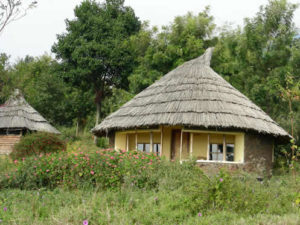 Mgahinga National Park is a neighbor to Bwindi Forest and thus there are several hotel and lodge options. Lodges are available near the park, in Kisoro and in Kabale town. Many of the hotels are located strategically so that visitors can use them as bases to do activities in both national parks. These lodges offer services that cater for budget, mid-range and luxury travelers. Thee lodges are built in form of basic campsites, bandas or standard cottages. Considering that some of the park activities like gorilla tracking starts very early in the morning, it is wise to book with a hotel that is not too far from park offices. Some of the hotels and lodges in Mgahinga Gorilla National Park are:
Mgahinga National Park is a neighbor to Bwindi Forest and thus there are several hotel and lodge options. Lodges are available near the park, in Kisoro and in Kabale town. Many of the hotels are located strategically so that visitors can use them as bases to do activities in both national parks. These lodges offer services that cater for budget, mid-range and luxury travelers. Thee lodges are built in form of basic campsites, bandas or standard cottages. Considering that some of the park activities like gorilla tracking starts very early in the morning, it is wise to book with a hotel that is not too far from park offices. Some of the hotels and lodges in Mgahinga Gorilla National Park are:
Chameleon Hill Lodge: This luxury lodge is built overlooking the beautiful Lake Mutanda. The lodge has a beautiful compound with great views of the three volcanoes in the park. It is good lodge for those who have come for gorilla trekking, bird watching, golden monkey tracking, visiting the Batwa or canoeing on Lake Mutanda.
Mount Gahinga Rest Camp: This lodge is built at the foot of the volcanoes with beautiful views of Lake Mutanda and the mountains in the park. There are nine grass thatched rooms (bandas) and three tents with private balconies. Besides the bandas, it is possible for visitors to pitch their own tents in designated places. Electricity is supplied using solar panels. The hotel arranges several activities including a visit to the Batwa people. The hotel is near a piece of land that demarcates the boundary between Uganda, Rwanda and Congo.
Mount Gahinga lodge: This lodge is owned by Volcanoes Safaris. The lodge is located near the park gate and in an area with natural setting and views of the Virunga Mountains. The hotel offers self-contained luxury bandas with a fireplace to contain the cold environment brought about by the volcanoes. The rooms are either twin/double or single. Bothe international and local delicious food is served to clients in the morning, afternoon and at night.
Clouds Mountain Gorilla lodge: Clouds Mountain is a luxury lodge built in the town of Kisoro. The lodge has eight cottages made of stone and grass thatched. The lodge has both twin and single rooms that are beautifully set up with a fireplace.
Traveler’s Nest Hotel: This is among the oldest hotels in Uganda. It is found outside Kisoro town with large spacious and comfortable rooms and a fireplace. The hotel is also built to offer spectacular views of the mountains in Mgahinga.
Virunga Hotel: This budget hotel is built behind the park office. The hotel rooms are self-contained with showers and generally clean interiors. There is also a bar, a restaurant and a large parking space.
Lake Mutanda Campsite: This campsite is suitable for those who love nature and wish to experience the African wilderness in a true natural setting. With great views Lake Mutanda and volcanoes in the park, this campsite offers affordable accommodation in an amazing environment.
Mutanda Lake Resort: Mutanda Lake Resort (Formerly Nkuringo Safari Lodge) is also built on the shores of Lake Mutanda between Nkuringo and Kisoro. 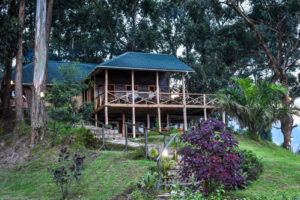 This location ensures that residents are treated to wonderful sightings of the volcanoes and the beautiful lake. This Resort is suitable for those who desire quality services but on a budget. Mutanda Lake Resort has tented self-contained rooms with 24/7 room and laundry services. The rooms are clean and spacious, each with a verandah. The Resort organizes birding trips by boat on Lake Mutanda, nature walks, visits to the gorilla highlands and Bwindi forest. Mutanda The resort is suitable for those who have come for gorilla trekking in either Mgahinga or Bwindi.
This location ensures that residents are treated to wonderful sightings of the volcanoes and the beautiful lake. This Resort is suitable for those who desire quality services but on a budget. Mutanda Lake Resort has tented self-contained rooms with 24/7 room and laundry services. The rooms are clean and spacious, each with a verandah. The Resort organizes birding trips by boat on Lake Mutanda, nature walks, visits to the gorilla highlands and Bwindi forest. Mutanda The resort is suitable for those who have come for gorilla trekking in either Mgahinga or Bwindi.
Bwindi Jungle Lodge: This lodge is built near Lake Mulehe. It is built strategically to offer accommodation facilities to visitors going to both Bwindi and Mgahinga National Park.
Amajambere Iwacu Community Camp: This budget facility is built next to the park gate and is run by the community around the camp. From the camp, residents get stunning views of the forests and the three volcanoes. The camp also has beautiful bandas and dormitories that are not too expensive. Residents in the dormitories share bathrooms but one can choose to stay in the self-contained rooms. Camping is allowed for those with their own equipment. The meals are mostly Ugandan dishes and are served at the communal area in the camp. A campfire is set late in the evening for guests with cultural performances from the Batwa. The thing about booking with this camp is that you indirectly contribute to the well-being of the community.

